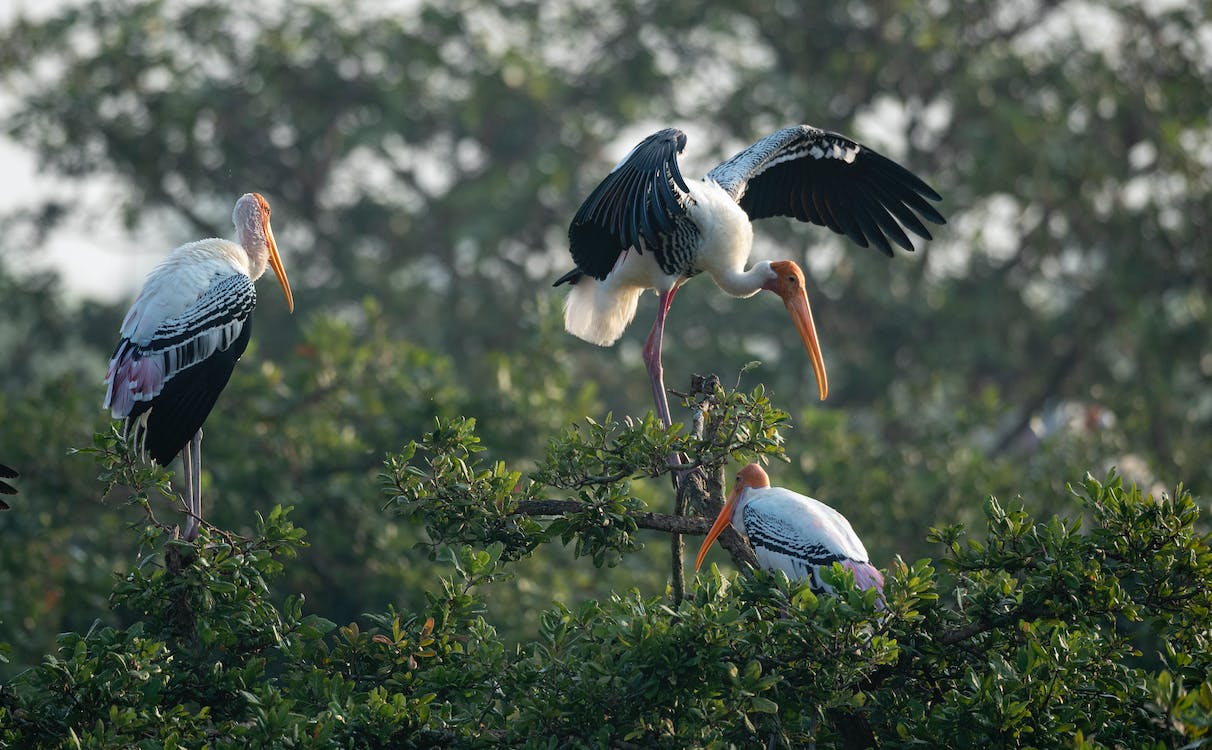It is a widespread tropical, elegant bird that thrives in Sub-Saharan Africa, India, and parts of Southeast Asia. It boasts a shiny black plumage with blue, purple, and green iridescence, which gives it its distinct appeal. However, it has a woolly white neck, from which it gets its name. Individuals or small groups occurs in agricultural areas, forest marshes, and freshwater wetlands, preying on insects and small vertebrates.
Read further to know more about the Woolly-necked Stork.
What is a Woolly-necked Stork?
The Woolly-necked Stork (Ciconia episcopus) is a large, long-legged bird from Ciconiidae’s stork family. Though the birds are usually silent, they may produce a croaking honk sound, which is rarely heard. They often noticed alone, walking calmly and slowly on the ground along the water. Otherwise, they stand motionless, resting on their tarsi.
Woolly-necked Storks also have broad wings spans and depend on switching between hot air thermals for longer, sustained flights. Same with other storks, they usually fly with their necks extending.
Its seven levels of classification are as follows:
Kingdom: Animalia
Phylum: Chordata
Class: Aves
Order: Ciconiiformes
Family: Ciconiidae
Genus: Ciconia
Species: C. episcopus
Woolly-necked Stork Physical Description
The Woolly-necked Stork is a medium-sized bird front the stork family, growing from 29 to 36 inches or 75 to 92 centimeters tall. It has a shiny plumage, accentuated by blue, purple, and green iridescence. Its all black except for its white woolly neck, lower belly, and undertail tectrix. Its beak is greyish with a red tip. Their eyes, legs, and feet are also red.
Females and males look alike, though males tend to be larger. Their juveniles are browner and paler, sans the rainbow-like iridescence from the plumage. When they reach the fledgling stage, they almost look like the adults, except for the feather forehead and fluffier feathers on their necks.
When they are in flight or mating displays, a thin stretch of unfeathered skin is noticeable through the forearm’s underside. It is often described as either red-gold or orange-red, which is said to be gleaming when examined at a closer range.
Where can they be spotted?
The Woolly-necked Stork is a widespread tropical species thriving and breeding in Africa, India, and Southeast Asia. They can live on any wetland habitat, such as rivers, ponds, lagoons, swaps, mudflats, flood plains, estuaries, croplands, irrigation lands, and dams.
Interesting Facts You Should Know About the Woolly-necked Stork
The Woolly-necked storks are nocturnal, able to forage at night with their keen night vision. It’s a perfect time to hunt for prey, as victims tend to be open and less-guarded at night. They are mainly carnivorous and feast on large insects, frogs, toads, fish, snakes, lizards, mollusks, and crabs. They walk calmly and slowly in water or vegetation, searching for prey and picking them up with their long bills.
These birds are monogamous, which means they only breed with one mate for life. Though they are often solitary nesters, they can be in small colonies of around five pairs. Parents make the nest jointly using sticks, with its center bowl brimmed with finer leaves, grass, and twigs. They place their nest on large tree forks, at least 10 meters above the water or ground.
Their egg-laying season usually starts in August and ends in December, producing a clutch of 2 to 4 eggs. Both parents incubate the eggs for about a month. Both males and females also brood and feed their offsprings. Chicks typically leave the nest in more or less two months before eventually dispersing independently nearly three weeks after.
While their population of Woolly-necked storks is not under threat worldwide, they are near-threatened in Africa. Their population in the region is decreasing due to the destruction of their habitats, persecution, and shooting. They are currently tagged as Vulnerable (VU) with a population size of around 35,000 individuals.
WILDLIFE PARKS AND RESERVES WHERE THIS SPECIES IS FOUND:
SOUTH AFRICA
NAMIBIA
BOTSWANA
ZIMBABWE
ZAMBIA
BOTSWANA BIRDS | SOUTH AFRICA BIRDS
NAMIBIA BIRDS | ZAMBIA BIRDS | ZIMBABWE BIRDS

